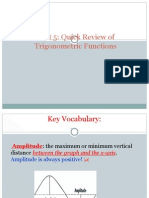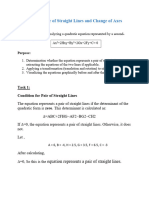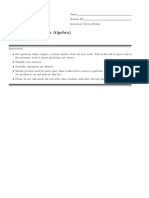Domains and Range
Uploaded by
Ida BerlianDomains and Range
Uploaded by
Ida BerlianFunctions
IB SL Revision
This revision guide uses information about quadratics, trigonometry, and exponentials. These are all covered in further details in other revision areas as well. Domains and Range Functions are mappings. Values go into the function and values come out of the function. The entire set of numbers that can be entered are called the domain and the entire set of numbers that output from the function is called the range. Often in a graphical question it may be easier to assume the domain as the x numbers and the range as the y numbers. Domain and range from an algebra function 2x2 3, x real number f: The domain of this function is defined as x real number, which means that x can be any integer (whole number) value, including negative numbers. By entering different types numbers it soon becomes apparent that the smallest number that is output by the function is -3. Some values have been shown below in the table. Input -5 5 0 20 -30 Output (mapping) 47 47 -3 797 1797 -3
So the domain is any value, and the range is f Inverse functions
An inverse function is one where the functions range is sent back to its domain. For example,
f ( x)
x + 3 and the inverse is f ( x)
x 3.
Putting x=2 into the function will give us 5. Putting 4 into the inverse function will get us back to 2, the number we started with. One other point about the inverse to remember is that a function will not have an inverse if it is not a one-to-one function.
www.ibmaths.com
Functions To find an inverse function:
f ( x) 3+ x 4
IB SL Revision
3+ x 4 4y = 3+ x y= 4y 3 = x f ( x) 1 = 4 x 3
Composite functions Composite functions are when we put two or more functions together. They are often written as follows:
f o g ( x)
This translates as: take function g(x) and put it into f(x). Example:
f ( x) x 2 + 1 and g ( x)
x . 4
Find (a) (a)
x 4
f og
2
(b) g o f (b)
+1
x2 + 1 4
www.ibmaths.com
Functions
IB SL Revision
Transformation of functions Functions can be transformed in the following ways: reflections; translations; and stretches. To demonstrate each transformation we will take the same function:
f ( x) x 2 . The function has the domain x 0 .
A graph of this function is as follows:
1. The inverse of the function produces a reflection in the line y= x.
www.ibmaths.com
Functions
IB SL Revision
2.
f ( x) gives a reflection in the line y = 0.
3. f ( x) gives a reflection in the line x = 0
www.ibmaths.com
Functions
IB SL Revision
4. f ( x) + 3 gives a translation by the vector
0 . 3
5. f ( x + 3) gives a translation by the vector
3 0
www.ibmaths.com
Functions
IB SL Revision
In questions 6 and 7 I have used the function f ( x) 6. 3 f ( x) gives a vertical stretch by a factor of 3.
ln( x) to illustrate the stretches.
www.ibmaths.com
Functions
IB SL Revision
7. f (3 x) gives a horizontal stretch by a factor of
1 . 3
Sine and Cosine functions Sine and cosine curves are often used to model real life situations, such as hours of sun or tidal times. The basic sine and cosine curves are shown below. It is important to have a basic grasp of the nature of these curve and trigonometry, especially angles between 0 and 360. Also you should be aware of the value of sin and cos that give 0 and 1. These are shown below in the table. sin 0 sin 90 sin 180 sin 360 cos 0 cos 90 cos 270 cos 360 0 1 0 0 1 0 0 1
www.ibmaths.com
Functions These values can be seen clearly from the sin and cos curves below. Basic curves y = sin x y = cos x
IB SL Revision
Adding a number to the curve y = (sin x) + 3
y = (cos x) + 3
Adding a number to the curve causes the curve to translate (slide) up. Subtracting a number from the curve causes the curve to translate (slide) down.
www.ibmaths.com
Functions Multiplying by a number y = 2sin x
IB SL Revision y = 2cos x
Multiplying the curve by a number causes the curve to be stretched y = sin (x+30)
Adding a number to x y = cos (x+30)
Adding a number to x has caused the curve to translate to the right.
www.ibmaths.com
Functions Multiplying the x number y = sin (3x)
IB SL Revision y = cos (3x)
Multiplying the x number causes the curve to oscillate more. More information on trig curves can be seen from the trig revision sheet. This covers the amplitude and period in more depth. All of the above can be put together in modelling questions. Particular use should be made of the values of sin and cos that give 0 and 1. The worked example below shows all this information clearly.
www.ibmaths.com
Functions
IB SL Revision
Guided example The height of the water in the harbour of Trumpton is tidal and modelled on a sine curve as shown in the diagram below.
The curve has the equation: h = sin (pt) + q where t = hours after midnight and h = height of the water in metres. (a) (b) Use your graph to find the height of the water at 10 AM. A yacht can only safely enter and leave the harbour when there is more than 3 metres of water in the harbour. Give the times of day when the ship can safely enter and leave the harbour. Find the values of p and q.
(c)
Answer (a) Answer (a) and (b) can be found by simply reading the graph. At 10 AM t = 10, so there is approximately 2.2 metres of water in the harbour. Answer (b) By looking at the graph the height is above 3 for 0 The corresponding times are: Midnight to 6 AM and 12 PM and 6 PM. t 6 and 12 t 18.
www.ibmaths.com
Functions
IB SL Revision
Answer (c) Since the curve has the equation h = sin (pt) + q we want to make use of sin 0 = 0. Looking at making sin (pt) = sin (0), we can make t = 0. It does not matter what the value of p is by taking t = 0 the sin (pt) becomes 0. When t = 0, h = 3, so we have the equation: 3 = sin (0) + q q=3 Using this value and making use of sin 90 = 1. Remember the sine curve features. It may be useful to draw the y = sin x on your TI and compare it to the curve in the question.
When sin 90 = 1 this is the top of the graph. In the modelled graph the curve is at its peak when t = 3. We only need take the sin (pt) = 1, so pt = 90 and we know that t = 3, so p is 30. By drawing the curve of y = sin (30x) + 3 on your TI you can check to see if it is the same as the curve given in the question (it is!). p = 30 and q = 3
www.ibmaths.com
Functions Exponential functions Remember: x0 = 1 x1 = x
IB SL Revision
Exponential functions are functions where the x number becomes a power. The functions below are all examples of exponentials. y = 2x An exponential curve looks like: y = 3-z y=
1x +3 2
A negative exponential curve is:
www.ibmaths.com
Functions Exponential curves have asymptotes. These are simply lines that the curve is heading towards but will never actually reach. In the two diagrams Example 1: y = 2x - 1
IB SL Revision below the asymptotes have been drawn on in dotted lines with the equation given below. Example 2: y = 2-x + 2
Asymptote: y = -1
Asymptote: y = 2
Look at the table opposite which shows a number of exponential functions and their asymptotes. Look for the pattern and you can get the next two asymptotes.
Function y = 2x + 3 y = 3-x - 5 y = ex 2.5 y = 0.5x y = ex + 0.5 y = 2x + 3 y = 2-x - 8
Asymptote y=3 y = -5 y = -2.5 y=0 y = 0.5 y=? y=?
www.ibmaths.com
Functions
IB SL Revision
Guided example The diagram below shows the function y = bx + a.
The curve passes through the coordinates (0, -4) and (1, -2). (a) Find the value of a. (b) Find the value of b. (c) Find the equation of the asymptote of the curve. Answer (a) Using the first coordinate we can substitute in values of x and y into the equation as follows: -4 = b0 + a Since b0 = 1 we now have: -4 = 1 + a a = -5 Answer (b) Now using the second set of coordinates: -2 = b1 5 Since b1 = b we now have: b=3 Answer (c) The asymptote can be found by ignoring the power of x part of the function, so the asymptote will be: y = -5
www.ibmaths.com
You might also like
- Applications and Use of The Inverse FunctionsNo ratings yetApplications and Use of The Inverse Functions15 pages
- Introduction To MATLAB 7 For Engineers: Functions and FilesNo ratings yetIntroduction To MATLAB 7 For Engineers: Functions and Files9 pages
- UNIT-3_MATLAB PROGRAMMING_QUESTION BANK_SOLUTION (1)No ratings yetUNIT-3_MATLAB PROGRAMMING_QUESTION BANK_SOLUTION (1)15 pages
- polynomial and rational functions slidesNo ratings yetpolynomial and rational functions slides91 pages
- M1L1_The Foolproof Method_with Example 3 IllustrationsNo ratings yetM1L1_The Foolproof Method_with Example 3 Illustrations7 pages
- Graph Transformations: Transformations "After" The Original FunctionNo ratings yetGraph Transformations: Transformations "After" The Original Function17 pages
- 4-5 Graphing Other Trigonometric Functions: Esolutions Manual - Powered by CogneroNo ratings yet4-5 Graphing Other Trigonometric Functions: Esolutions Manual - Powered by Cognero22 pages
- Curve Sketching Is Another Practical Application of Differential CalculusNo ratings yetCurve Sketching Is Another Practical Application of Differential Calculus11 pages
- Lesson02 Acatalogueofessentialfunctions011slides 110126145141 Phpapp01No ratings yetLesson02 Acatalogueofessentialfunctions011slides 110126145141 Phpapp0147 pages
- Curves: Lecture Notes of Computer Graphics Prepared by DR - Eng. Ziyad Tariq Al-Ta'iNo ratings yetCurves: Lecture Notes of Computer Graphics Prepared by DR - Eng. Ziyad Tariq Al-Ta'i14 pages
- Mathematical Techniques For Economic Analysis: Australian National University DR Reza HajargashtNo ratings yetMathematical Techniques For Economic Analysis: Australian National University DR Reza Hajargasht60 pages
- Notes On "Applied Calculus", Flath/Gleason/et - Al.No ratings yetNotes On "Applied Calculus", Flath/Gleason/et - Al.128 pages
- PPT03 The Vertical Line Test and GradientNo ratings yetPPT03 The Vertical Line Test and Gradient20 pages
- Matematika Teknik (Tei 101) Preliminary: Warsun Najib, S.T., M.SCNo ratings yetMatematika Teknik (Tei 101) Preliminary: Warsun Najib, S.T., M.SC18 pages
- 6-1Lesson_Presentation_Graphing_Exponential_Functions (1)No ratings yet6-1Lesson_Presentation_Graphing_Exponential_Functions (1)56 pages
- Math 313-11 (Linear Algebra) Practice Exam 1No ratings yetMath 313-11 (Linear Algebra) Practice Exam 18 pages
- Vectors in Two Dimensions: Read Chapter 1.6-1.9No ratings yetVectors in Two Dimensions: Read Chapter 1.6-1.931 pages
- Problems Proposed by Vasc and Arqady - Edited by Sayan MukherjeeNo ratings yetProblems Proposed by Vasc and Arqady - Edited by Sayan Mukherjee13 pages
- 62221-Texto del artículo-358832-1-10-20171124No ratings yet62221-Texto del artículo-358832-1-10-201711246 pages
- Lecture Notes on Geometric QuantizationNo ratings yetLecture Notes on Geometric Quantization391 pages
- Year 7 Autumn 2 Algebraic Notation Mini Assessment A 2No ratings yetYear 7 Autumn 2 Algebraic Notation Mini Assessment A 22 pages
- Example II Matrix Chain Multiplication ProblemNo ratings yetExample II Matrix Chain Multiplication Problem14 pages
- Chiang Wainwright Fundamental Methods CH 2 3 Solutions60% (5)Chiang Wainwright Fundamental Methods CH 2 3 Solutions7 pages
- The Story of Fermat's Last Theorem (Akanksha)No ratings yetThe Story of Fermat's Last Theorem (Akanksha)10 pages
- Algebraic Derivation of Generalized Cubic EOSNo ratings yetAlgebraic Derivation of Generalized Cubic EOS4 pages
- Practice Questions Real Numbers Class X Set 02 AnswersNo ratings yetPractice Questions Real Numbers Class X Set 02 Answers7 pages
- Exercise # 1 Objective Type Questions: Paliwal Kisan Baazar, 1 Floor, H - 226 (R), IPIA, Road No. 5, Kota (Raj.)No ratings yetExercise # 1 Objective Type Questions: Paliwal Kisan Baazar, 1 Floor, H - 226 (R), IPIA, Road No. 5, Kota (Raj.)4 pages
- 2D Transformations and Homogeneous Coordinates: DR Nicolas HolzschuchNo ratings yet2D Transformations and Homogeneous Coordinates: DR Nicolas Holzschuch25 pages
- [MELC] General Math Curriculum Map and Release Schedule - Gen MathNo ratings yet[MELC] General Math Curriculum Map and Release Schedule - Gen Math6 pages
- (23007451 - Special Matrices) Best Linear Unbiased Estimation For Varying Probability With and Without Replacement SamplingNo ratings yet(23007451 - Special Matrices) Best Linear Unbiased Estimation For Varying Probability With and Without Replacement Sampling14 pages
- Introduction To MATLAB 7 For Engineers: Functions and FilesIntroduction To MATLAB 7 For Engineers: Functions and Files
- UNIT-3_MATLAB PROGRAMMING_QUESTION BANK_SOLUTION (1)UNIT-3_MATLAB PROGRAMMING_QUESTION BANK_SOLUTION (1)
- M1L1_The Foolproof Method_with Example 3 IllustrationsM1L1_The Foolproof Method_with Example 3 Illustrations
- Graph Transformations: Transformations "After" The Original FunctionGraph Transformations: Transformations "After" The Original Function
- 4-5 Graphing Other Trigonometric Functions: Esolutions Manual - Powered by Cognero4-5 Graphing Other Trigonometric Functions: Esolutions Manual - Powered by Cognero
- Curve Sketching Is Another Practical Application of Differential CalculusCurve Sketching Is Another Practical Application of Differential Calculus
- Lesson02 Acatalogueofessentialfunctions011slides 110126145141 Phpapp01Lesson02 Acatalogueofessentialfunctions011slides 110126145141 Phpapp01
- Curves: Lecture Notes of Computer Graphics Prepared by DR - Eng. Ziyad Tariq Al-Ta'iCurves: Lecture Notes of Computer Graphics Prepared by DR - Eng. Ziyad Tariq Al-Ta'i
- Mathematical Techniques For Economic Analysis: Australian National University DR Reza HajargashtMathematical Techniques For Economic Analysis: Australian National University DR Reza Hajargasht
- Notes On "Applied Calculus", Flath/Gleason/et - Al.Notes On "Applied Calculus", Flath/Gleason/et - Al.
- Matematika Teknik (Tei 101) Preliminary: Warsun Najib, S.T., M.SCMatematika Teknik (Tei 101) Preliminary: Warsun Najib, S.T., M.SC
- 6-1Lesson_Presentation_Graphing_Exponential_Functions (1)6-1Lesson_Presentation_Graphing_Exponential_Functions (1)
- Shortcuts to College Calculus Refreshment KitFrom EverandShortcuts to College Calculus Refreshment Kit
- A-level Maths Revision: Cheeky Revision ShortcutsFrom EverandA-level Maths Revision: Cheeky Revision Shortcuts
- Problems Proposed by Vasc and Arqady - Edited by Sayan MukherjeeProblems Proposed by Vasc and Arqady - Edited by Sayan Mukherjee
- Year 7 Autumn 2 Algebraic Notation Mini Assessment A 2Year 7 Autumn 2 Algebraic Notation Mini Assessment A 2
- Chiang Wainwright Fundamental Methods CH 2 3 SolutionsChiang Wainwright Fundamental Methods CH 2 3 Solutions
- Practice Questions Real Numbers Class X Set 02 AnswersPractice Questions Real Numbers Class X Set 02 Answers
- Exercise # 1 Objective Type Questions: Paliwal Kisan Baazar, 1 Floor, H - 226 (R), IPIA, Road No. 5, Kota (Raj.)Exercise # 1 Objective Type Questions: Paliwal Kisan Baazar, 1 Floor, H - 226 (R), IPIA, Road No. 5, Kota (Raj.)
- 2D Transformations and Homogeneous Coordinates: DR Nicolas Holzschuch2D Transformations and Homogeneous Coordinates: DR Nicolas Holzschuch
- [MELC] General Math Curriculum Map and Release Schedule - Gen Math[MELC] General Math Curriculum Map and Release Schedule - Gen Math
- (23007451 - Special Matrices) Best Linear Unbiased Estimation For Varying Probability With and Without Replacement Sampling(23007451 - Special Matrices) Best Linear Unbiased Estimation For Varying Probability With and Without Replacement Sampling

























































































